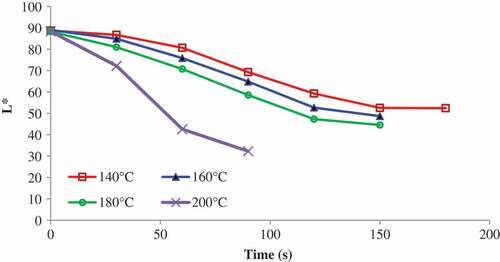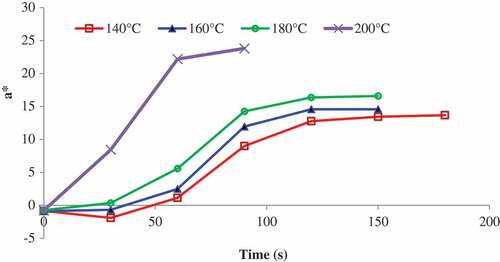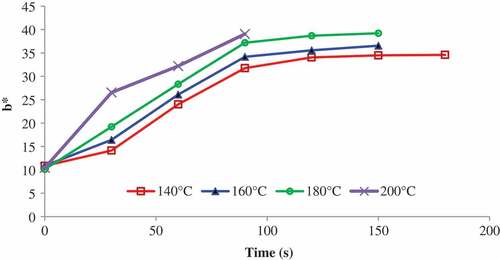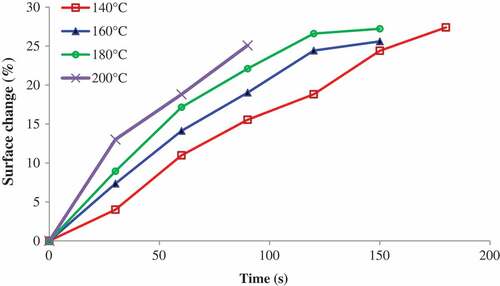 ?Mathematical formulae have been encoded as MathML and are displayed in this HTML version using MathJax in order to improve their display. Uncheck the box to turn MathJax off. This feature requires Javascript. Click on a formula to zoom.
?Mathematical formulae have been encoded as MathML and are displayed in this HTML version using MathJax in order to improve their display. Uncheck the box to turn MathJax off. This feature requires Javascript. Click on a formula to zoom.ABSTRACT
Kohlrabi is used for consumption in various regions of the world as, raw, cooked or fried. Heat and mass transfer phenomena take place during frying cause physicochemical changes, which affect the color and surface of the fried products. The effect of frying temperature on the color changes and center temperature change during deep fat frying of kohlrabi was investigated. The color scale parameters redness (a*), yellowness (b*) and lightness (L*), and color change intensity (∆E) were used to estimate color changes during frying as a function of oil temperature and time. L* value of fried kohlrabi decreased during frying but a* and b* values were increased. A first-order kinetic equation was used for each one of the three color parameters, in which the rate constant is a function of oil temperatures. The results showed that oil temperature has a significant effect on the color parameters. Different kinetic models were used to fit the experimental data, and the results revealed that the power model was the most suitable to describe the color change intensity (∆E). Center temperature of kohlrabi slice increased with an increase in oil temperature and time during frying.
Introduction
Kohlrabi (Brassica oleracea var. gongylodes), belonging to the family Cruciferae (Brassicaceae), is a biennial, herbaceous vegetable crop grown as an annual that produces a swollen, bulb-like stem. It is a minor crop grown in temperate countries and in some subtropical areas. The tubers or swollen stems that develop above the ground may be due to secondary growth in thickness. The tuber is harvested before it becomes tough or woody.[Citation1] Kohlrabi is used for consumption in various regions of the world as, raw, cooked or fried. Effect of cooking methods on the phytosterol content in nine selected vegetables studied by Shin, Park, and Lee.[Citation2] Total phytosterol content was found to be high in raw kohlrabi at 138.99 mg/kg fw (0.01%). high content variation of total phytosterol was found in stir-fried and deep-fried vegetables. The applicability of kohlrabi for producing ready-to-use and ready-to-eat ovo-vegetarian diets was studied by Barakat.[Citation3] They produced kohlrabi based ovo-vegetarian diets using kohlrabi vegetable and provided a promising approach for improving the traditional meals and beneficial for human health.
Frying is a complex unit operation that is widely used in the food industry. During the process, food is immersed in an oil bath at a temperature above the boiling point of water. This results in a counter flow of water vapor (bubbles) and oil at the surface of the product.[Citation4,Citation5] Heat and mass transfer phenomena take place during frying cause physicochemical changes, which affect the color and surface of the fried products. Process variables such as oil temperature and oil type are expected to affect the color of the fried products. Although the investigation on color properties of fried products has started many years ago, it has continued with increasing interest in recent years.
Krokida, Oreopoulou, Maroulis, and Marinos-Kouris[Citation6] studied the effect of oil temperature, oil type and sample thickness on color changes during deep fat frying of french fries. They reported that oil temperature and thickness of potato strips have a significant effect on the color parameters, which are not affected by the use of hydrogenated oil in the frying medium. Paul and Mittal[Citation7] examined how the degradation of oil during frying of canola affected the color of the fried product. They noted high correlations between the color parameters and oil degradation during frying. Kozempel, Tomasula and Craig[Citation8] developed a simulator for food processes such as blanching, drying, and frying of potatoes. The model was also used to control the color of fried potatoes. Khalil[Citation9] examined the quality of french fried potatoes as influenced by the coating with hydrocolloids. They noted that coated french fries exhibited higher red and yellow colors. The effect of frying temperatures and durations on the quality of vacuum fried jackfruit chips was evaluated by the Canadian Institute of Food Science and Technology JournalMaity, Bawa, and Raju.[Citation10] Jackfruit chips fried at a higher temperature resulted in maximum shrinkage (48%). The lightness in terms of hunter value decreased significantly during frying. Frying at lower temperatures was found to retain bioactive compounds such as total phenolics, total flavonoids, and total carotenoids in jackfruit chips. Effects of frying treatments on texture (hardness) and color parameters (L*, a*, b*, and ΔE) during deep fat frying of yellow fleshed cassava root slices were investigated by Oyedeji, Sobukola, Henshaw, Adegunwa, Ijabadeniyi, Sanni and Tomlins.[Citation11] The overall color change in chips fried under vacuum conditions at 118°C and 8 min was the least (21.20) compared to fresh and atmospherically pre-dried ones (16.69 and 14.81, respectively). Vacuum frying is an alternative method to produce high-quality vegetable or fruit chips was studied by Fan, Zhang, and Mujumdar.[Citation12] The effect of frying temperature and vacuum degree on moisture content, oil content, color, and texture of fried carrot chips were investigated. Statistical analysis of the color data showed that there were no significant differences in lightness (L*), redness (a*), and yellowness (b*) of carrot chips as a function of vacuum degree and temperature.
The aim of this research was to study the effect of changes in frying temperature on the color parameters, surface changes, and heat transfer during fat frying of kohlrabi slice and to specifically investigate changes in these quality attributes at each frying time, and determine kinetic parameters for these changes.
Materials and methods
Frying of kohlrabi
Kohlrabies were purchased from a local supermarket and stored at 7°C and 90–95% relative humidity. Slices of kohlrabi with 10 mm thickness were prepared with the aid of a steel cutter and were immediately placed into the fryer. A fryer with temperature control of ±1°C was used (Lutron, TM-916). Refined sunflower oil (Ladanoil, Iran) was used as the frying media. Frying temperatures of kohlrabi slices were set at 140°C, 160°C, 180°C, and 200°C. All experiments were performed in triplicate, and the present results are the average of the obtained individual values.
Color measurement
In order to investigate the effect of frying temperature on color changes of fried kohlrabi, a computer vision system was applied. Sample illumination was achieved with HP Scanner (Hp Scanjet 300). Since the computer vision system perceived color as RGB signals, which is device-dependent, the taken images were converted into L*a*b* units to ensure color reproducibility.[Citation13] L* (lightness-darkness that ranges from 0 to 100), a*(redness-greenness that ranges from −120 to 120) and b* (yellowness-blueness that ranges from −120 to 120) were measured in this study.[Citation14]
The calculation of color changes (ΔE) for the total color difference was made with the following equations[Citation15]:
where ΔE is the total color changes (dimensionless), ΔL* is the lightness changes (before and after frying), Δa* is the redness changes and Δb* is the yellowness changes.
The change in the surface of the kohlrabi slice during frying is calculated using the following equation:
where ΔA is the surface change percent (dimensionless), A0 and At (m2) are surface of kohlrabi at first time (fresh kohlrabi) and frying period, respectively.
In this study, the image analysis of dried gums was performed using Image J software version 1.42e, USA.
Mathematical modeling
A first-order kinetic model was chosen to describe the color changes within the frying process.
where C is the color parameter (L*, a*, b*), Ce the equilibrium value, KC the rate constant (min −1) of each color parameter, t is the frying time (min).
At zero time each color parameter (L*, a*, b*) has an initial value Ci. The effect of process variables on the color parameters during frying can be embodied into the following empirical equations, which are similar to those proposed for frying kinetic EquationEquations (5(5)
(5) , Citation6):
The estimation of the above parameters for each one of the color parameters was carried out using a non-linear regression analysis method, separately for each color parameter during frying of kohlrabi.
In addition, power and quadratic models were chosen to describe the color changes intensity (ΔE) within the frying process:
Power model:
Quadratic model:
The experimental data were modeled by using non-linear regression in Curve Expert 1.34 software.
Temperature profiles
A thin thermocouple (Type K) was inserted in the center of the kohlrabi samples, assuring the position by the measure of the sample dimensions. The temperatures at the geometric center of the sample and bulk oil were measured, with sampling time (t) frequency of 5 s by means of the thermocouples (Lutron, TM-916, Taiwan).
Results and discussion
– show changes in L*, a*, and b* values of kohlrabi slices for increasing frying times and temperature during frying. L* is a critical parameter in the frying industry as it is usually the first quality attribute evaluated by consumers when determining product acceptance. Low L* values indicate a dark color and are mainly associated with non-enzymatic browning reactions.[Citation4] The results of the experimental lightness data are shown in . As shown in , the L* value of fried kohlrabi decreased during frying. For instance, L* value diminished from L0* = 88.32 to L* = 32.30 at end point (much darker) when frying at 200°C. Oil temperature has a negative effect on the lightness of fried kohlrabi. The change in L* value was less at lower frying temperature. As the temperature of frying increased from 140°C to 200°C, the lightness of kohlrabi decreased from 52.39 to 32.30, respectively. In general, an L* parameter decrease is not desired because that means a more dark product, which is not acceptable for fried kohlrabi. The decrease in L* value has been linked with nonenzymatic browning reactions which accelerates at high temperatures.[Citation4,Citation16]
It was also observed that the rate of reduction in the values for lightness parameter at lower frying temperatures is slower compared to the rate observed at higher frying times across all frying temperatures. Similar behavior in fried potato chips was reported by Nourian, Ramaswamy, and Kushalappa.[Citation17] Since lightness is a very important color quality parameter, lower frying temperatures with a lower boiling point of water are preferable to preserve the lightness and hence the attractiveness of fried products.[Citation11]
The reduction in L* may be attributed to intense browning reaction and increase crust formation due to exposure to high temperature.[Citation16]
As with the case of the redness parameter, a* is also affected by the oil temperature and frying time (). As shown in this figure the redness of fried kohlrabi increased during frying (become more red).
As shown in the yellowness of fried kohlrabi increased during frying. In general higher b* parameter values give more yellow products, which is desirable for fried products.
Kohlrabi slices fried under different oil temperature showed a significant decrease in their color coordinates, reaching final values of a* = 23.80 and b* = 39.05, when frying at 200°C.
The mathematical model was fitted to the experimental color data simultaneously for process variable examined, and the parameter estimation resulted from fitting EquationEquation (5)(5)
(5) to the experimental data. The results of fitting the proposed first-order kinetic model to the experimental data are reported in . The elimination of parameters KC and a for each color parameter gave an acceptable agreement between experimental and calculated values, as found by comparison of the values R and SE.
Table 1. The values of the color kinetic model coefficients during frying of kohlrabi
In color change (ΔE) is presented as functions of frying time. As shown in the ΔE, increased frying during. The color change intensity (ΔE) gets more intense at higher temperatures. Vacuum frying of potato chips was studied by Garayo and Moreira[Citation18] they reported that the change in total color difference was affected by frying conditions and there was a change observed in total color during deep fat frying of potato chips at atmospheric and vacuum conditions.
The mathematical models were fitted to the color change (ΔE) data and the parameter estimation resulted from fitting EquationEquation (6)(6)
(6) and (Equation7
(7)
(7) ) to the experimental data. The results of fitting the proposed power model to the experimental data are reported in .
Table 2. The values of the kinetic model coefficients of color change (ΔE) during frying of kohlrabi
Kinetics of moisture loss and oil uptake during deep fat frying of Gethi (Dioscorea kamoonensis Kunth) strips was studied by Manjunatha, Ravi, Negi, Raju, and Bawa.[Citation19] The hunter color parameters were significantly affected by frying temperature and frying time. The L* value increased with respect to frying time initially, followed by decline and the same trend was observed at higher temperatures of frying with elevated rate, whereas a* value increased with time as well as the temperature of frying and obeyed zero order rate equation. In addition, chroma, hue angle, and total color difference were markedly affected by frying temperature as well as frying time. In another study, the total color change of tofu during frying at different temperatures was studied and it increased exponentially and followed first order kinetic equation. The increase in the magnitude of total color difference values could be attributed to the high temperature and low moisture content, which initiated the nonenzymatic browning such as maillard reaction and caramelization of sugars.[Citation20]
Surface change % (shrinkage) is a common phenomenon during frying. Rapid water loss resulted in significant shrinkage in chips during frying.[Citation10]
In surface changes is presented as functions of frying time and oil temperature. As shown in this figure, the surface change % was increased with the progression of frying time. As soon as the kohlrabi slices were introduced in the low frying medium, the slices shrunk. As the temperature of frying increased from 140°C to 200°C, the surface change % of kohlrabi slices decreased from 27.40% to 25.09%, respectively. At the end of frying the % surface change in kohlrabi slices was 27.40%, 25.61%, 27.22%, and 25.06% at 140, 160, 180,and 200°C, respectively. High surface change was seen in kohlrabi slices fried at 130°C, which may be due to low removal of moisture. Similar behavior was also reported in the change in shrinkage during vacuum frying of banana chips.[Citation21] Higher shrinkage in potato chips was also reported during high-temperature frying.[Citation22]
The effect of oil temperature on the center temperature change of kohlrabi during frying is shown in . Center temperature of kohlrabi slice increased with an increase in oil temperature (faster heat transfer) and time during frying. The center temperature increased rapidly at the beginning. This profile is basically due to the sample unstable heating and water evaporation phenomenon from the surface. Within the experimental conditions studied, a difference between the maximum sample temperature and the oil temperature was recorded, in which the center temperature of most of the samples reached 95 for 140°C, 97 for 160°C, 99 for 180°C and 108, for 200°C, respectively.
The frying time to get the desirable color of the kohlrabi slice was different for each oil temperature; the characteristic time decreased with increasing temperature, which is to be expected since the rate of heating is higher.
Effect of temperature on the physical properties of chicken strips during deep-fat frying studied by Vélez-Ruiz, Vergara-Balderas, Sosa-Morales, and Xique-Hernández.[Citation23] The center temperature of chicken strips increased quickly at the beginning and had a plateau at around 95–105°C from 1 to 4 min, for the oil temperature equal 130–150°C.
Conclusion
Colour parameter (L*, a*, b*) changes of kohlrabi that take place during frying can be described by an empirical first-order kinetic model. Oil temperature and frying time are the process parameters, which affect the color parameters during frying. The color change phenomenon gets more intense at higher temperatures. Kohlrabi slices fried under different oil temperature showed a significant decrease in their color coordinates, reaching final values of a* = 23.80 and b* = 39.05, when frying at 190°C. Different kinetic models were used to fit the experimental data, and the results revealed that the power model was the most suitable to describe the color change intensity (∆E). The center temperature of kohlrabi slice increased rapidly at the beginning of the frying process.
References
- Kalloo, G.;. Genetic Improvement of Vegetable Crops; Pergamon Press: Oxford, New York. 1993. pp 191–194.
- Shin, J.-A.; Park, J.-M.; Lee, K.-T. Effect of Cooking Methods on the Phytosterol Content in Nine Selected Vegetables. Korean J. Agr. Sci. 2016, 43, 87–99. Doi:10.7744/kjoas.20160011.
- Barakat, H.;. Characterization and Evaluation of Kohlrabi (Brassica Oleracea L. Gongylodes) and Kohlrabibased Ovo-Vegetarian Diets as New Food Recipes. Egypt. J. Food Sci. 2013, 41, 35–61.
- Dueik, V.; Robert, P.; Bouchon, P. Vacuum Frying Reduces Oil Uptake and Improves the Quality Parameters of Carrot Crisps. Food Chem.. 2010, 119, 1143–1149. DOI: 10.1016/j.foodchem.2009.08.027.
- Salehi, F.;. Color Changes Kinetics during Deep Fat Frying of Carrot Slice. Heat Mass Transfer. 2018, 54, 3421–3426. DOI: 10.1007/s00231-018-2382-7.
- Krokida, M.; Oreopoulou, V.; Maroulis, Z.; Marinos-Kouris, D. Colour Changes during Deep Fat Frying. J. Food Eng.. 2001, 48, 219–225. DOI: 10.1016/S0260-8774(00)00161-8.
- Paul, S.; Mittal, G. Dynamics of Fat/Oil Degradation during Frying Based on Optical Properties. J. Food Eng.. 1996, 30, 389–403. DOI: 10.1016/S0260-8774(96)00020-9.
- Kozempel, M. F.; Tomasula, P.; Craig, J. C. The Development of the ERRC Food Process Simulator. Simul. Pract. Th.. 1995, 2, 221–236. Doi:10.1016/0928-4869(94)00017-A.
- Khalil, A.;. Quality of French Fried Potatoes as Influenced by Coating with Hydrocolloids. Food Chem.. 1999, 66, 201–208. DOI: 10.1016/S0308-8146(99)00045-X.
- Canadian Institute of Food Science and Technology JournalMaity, T., Bawa, A.; Raju, P. Effect of Vacuum Frying on Changes in Quality Attributes of Jackfruit (Artocarpus Heterophyllus) Bulb Slices. Int. J. Food Sci.. 2014, 2014, 1–8.
- Oyedeji, A. B.; Sobukola, O. P.; Henshaw, F.; Adegunwa, M. O.; Ijabadeniyi, O. A; Sanni, L. O; Tomlins, K. I. Effect of Frying Treatments on Texture and Colour Parameters of Deep Fat Fried Yellow Fleshed Cassava Chips. J. Food Qual.. 2017, 2017, 1–10. DOI: 10.1155/2017/8373801.
- Fan, L.-P.;. Zhang, M., Mujumdar, A. S., Vacuum Frying of Carrot Chips. Drying Technol.. 2005, 23, 645–656. DOI: 10.1081/DRT-200054159.
- Salehi, F.;. Rheological and Physical Properties and Quality of the New Formulation of Apple Cake with Wild Sage Seed Gum (Salvia Macrosiphon). J. Food Meas. Charact.. 2017, 11, 2006–2012. DOI: 10.1007/s11694-017-9583-5.
- Salehi, F.; Kashaninejad, M. Effect of Drying Methods on Rheological and Textural Properties, and Color Changes of Wild Sage Seed Gum. J. Food Sci. Technol.. 2015, 52, 7361–7368. DOI: 10.1007/s13197-015-1849-5.
- Salehi, F.; Kashaninejad, M. Effect of Different Drying Methods on Rheological and Textural Properties of Balangu Seed Gum. Drying Technol.. 2014, 32, 720–727. DOI: 10.1080/07373937.2013.858264.
- Mariscal, M.; Bouchon, P. Comparison between Atmospheric and Vacuum Frying of Apple Slices. Food Chem.. 2008, 107, 1561–1569. DOI: 10.1016/j.foodchem.2007.09.031.
- Nourian, F.; Ramaswamy, H.; Kushalappa, A. Kinetic Changes in Cooking Quality of Potatoes Stored at Different Temperatures. J. Food Eng.. 2003, 60, 257–266. DOI: 10.1016/S0260-8774(03)00046-3.
- Garayo, J.; Moreira, R. Vacuum Frying of Potato Chips. J. Food Eng.. 2002, 55, 181–191. DOI: 10.1016/S0260-8774(02)00062-6.
- Manjunatha, S.; Ravi, N.; Negi, P.; Raju, P.; Bawa, A. Kinetics of Moisture Loss and Oil Uptake during Deep Fat Frying of Gethi (Dioscorea Kamoonensis Kunth) Strips. J. Food Sci. Technol.. 2014, 51, 3061–3071. DOI: 10.1007/s13197-012-0841-6.
- Baik, O.; Mittal, G. Kinetics of Tofu Color Changes during Deep-Fat Frying. LWT Food Sci. Technol.. 2003, 36, 43–48. DOI: 10.1016/S0023-6438(02)00175-5.
- Yamsaengsung, R.; Ariyapuchai, T.; Prasertsit, K. Effects of Vacuum Frying on Structural Changes of Bananas. J. Food Eng.. 2011, 106, 298–305. DOI: 10.1016/j.jfoodeng.2011.05.016.
- Yagua, C. V.; Moreira, R. G. Physical and Thermal Properties of Potato Chips during Vacuum Frying. J. Food Eng.. 2011, 104, 272–283. DOI: 10.1016/j.jfoodeng.2010.12.018.
- Vélez-Ruiz, J.; Vergara-Balderas, F.; Sosa-Morales, M.; Xique-Hernández, J. Effect of Temperature on the Physical Properties of Chicken Strips during Deep-Fat Frying. Int. J. Food Prop.. 2002, 5, 127–144. DOI: 10.1081/JFP-120015596.






